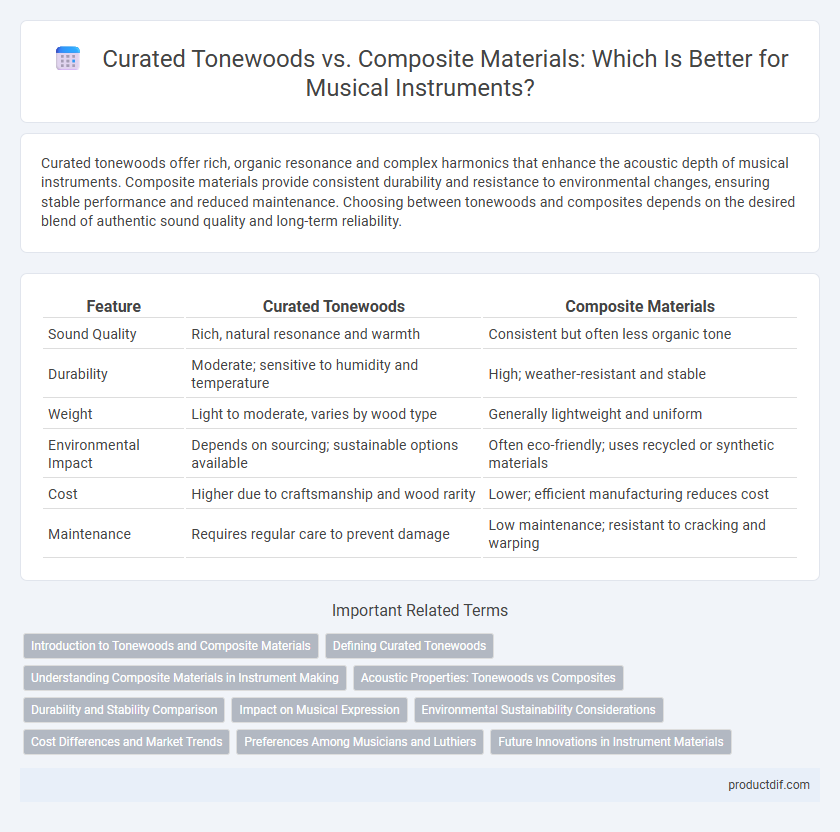Curated tonewoods offer rich, organic resonance and complex harmonics that enhance the acoustic depth of musical instruments. Composite materials provide consistent durability and resistance to environmental changes, ensuring stable performance and reduced maintenance. Choosing between tonewoods and composites depends on the desired blend of authentic sound quality and long-term reliability.
Table of Comparison
| Feature | Curated Tonewoods | Composite Materials |
|---|---|---|
| Sound Quality | Rich, natural resonance and warmth | Consistent but often less organic tone |
| Durability | Moderate; sensitive to humidity and temperature | High; weather-resistant and stable |
| Weight | Light to moderate, varies by wood type | Generally lightweight and uniform |
| Environmental Impact | Depends on sourcing; sustainable options available | Often eco-friendly; uses recycled or synthetic materials |
| Cost | Higher due to craftsmanship and wood rarity | Lower; efficient manufacturing reduces cost |
| Maintenance | Requires regular care to prevent damage | Low maintenance; resistant to cracking and warping |
Introduction to Tonewoods and Composite Materials
Tonewoods are natural woods like mahogany, maple, and rosewood, prized for their acoustic properties and resonance in musical instrument construction. Composite materials such as carbon fiber and fiberglass offer consistent density and durability, providing enhanced resistance to environmental changes and physical wear. The choice between curated tonewoods and composite materials impacts the instrument's sound quality, playability, and long-term stability.
Defining Curated Tonewoods
Curated tonewoods are specifically selected natural woods known for their unique acoustic properties, grain patterns, and resonance qualities that enhance a musical instrument's sound and aesthetics. These woods often undergo careful drying and aging processes to improve stability and tonal richness, making them preferred for high-end guitars, violins, and pianos. Their organic structure contributes to a warm, complex sound profile that many musicians and luthiers seek over synthetic composite materials.
Understanding Composite Materials in Instrument Making
Composite materials in musical instrument making consist of engineered substances combining fibers like carbon or glass with resin matrices to enhance strength, durability, and resistance to environmental changes. These materials offer consistent tonal qualities and reduced weight compared to traditional tonewoods, making them ideal for modern production and performance needs. Their stability against humidity and temperature fluctuations ensures precise sound reproduction and longevity in various climates.
Acoustic Properties: Tonewoods vs Composites
Tonewoods, such as spruce and mahogany, offer superior acoustic resonance and natural sustain due to their unique cellular structures, enhancing warmth and tonal complexity in musical instruments. Composite materials, while more durable and resistant to environmental changes, typically produce a brighter, less nuanced sound with reduced harmonic richness and dynamic response. Musicians seeking authentic, rich acoustic qualities often prefer tonewoods for their balanced frequency spectrum and organic vibration characteristics.
Durability and Stability Comparison
Curated tonewoods, known for their natural grain and resonance, offer excellent acoustic qualities but can be susceptible to environmental changes like humidity and temperature fluctuations, impacting durability and stability. Composite materials, engineered for uniformity and resistance, provide enhanced stability and durability by minimizing warping, cracking, and moisture absorption. Musicians seeking long-term reliability in diverse conditions often prefer composite materials, while aficionados prioritize the organic tonal complexity of curated tonewoods.
Impact on Musical Expression
Curated tonewoods provide rich, resonant acoustic qualities that enhance a musician's ability to convey subtle dynamics and tonal nuances, contributing to expressive depth. Composite materials offer consistency and durability, allowing for reliable performance across varied environments but may lack the organic warmth and complex overtones prized in traditional instruments. Choosing between the two impacts the instrument's responsiveness and the emotional connection achieved during musical expression.
Environmental Sustainability Considerations
Curated tonewoods are sourced from sustainably managed forests and often undergo certification processes like FSC to ensure environmental responsibility, promoting biodiversity and carbon sequestration. Composite materials, typically made from recycled fibers and resins, reduce deforestation impact and often have a smaller carbon footprint during production, offering a durable and eco-friendly alternative. Choosing between these materials involves balancing natural resource conservation with lifecycle emissions and potential for recycling or reuse in musical instrument manufacturing.
Cost Differences and Market Trends
Curated tonewoods, prized for their unique resonance and natural aesthetics, often carry higher price tags due to limited availability and traditional sourcing methods. Composite materials, favored for affordability and durability, have gained market traction by offering consistent quality at a fraction of the cost. Recent trends show a growing demand for sustainable and cost-effective instruments, driving manufacturers to increasingly incorporate composite materials while preserving tonal integrity through advanced engineering.
Preferences Among Musicians and Luthiers
Musicians and luthiers often prefer curated tonewoods for their rich, resonant sound quality and natural aesthetic, which contribute to unique instrument timbres. Composite materials gain favor for their durability, resistance to environmental changes, and consistent tonal performance, especially in demanding performance settings. Preference typically hinges on the desired balance between traditional tonal warmth and modern reliability in instrument construction.
Future Innovations in Instrument Materials
Future innovations in musical instrument materials are increasingly exploring hybrid designs that combine the acoustic richness of curated tonewoods with the durability and consistency of composite materials. Advanced composites infused with nanotechnology promise enhanced resonance, reduced weight, and greater environmental sustainability compared to traditional woods like spruce or mahogany. Research into bioengineered tonewoods and recyclable composites aims to revolutionize sound quality and production efficiency in guitars, violins, and other stringed instruments.
Curated Tonewoods vs Composite Materials Infographic

 productdif.com
productdif.com